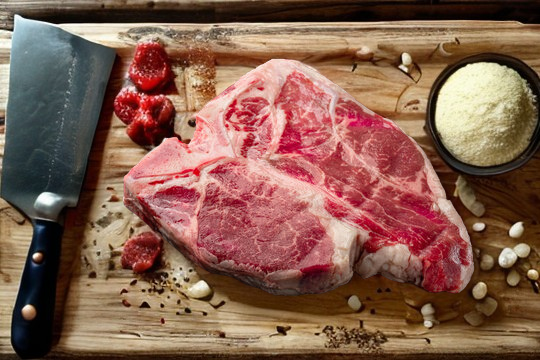What is a porterhouse steak? This question often comes up when people want to understand premium beef cuts. A porterhouse steak is one of the most prized cuts of beef, combining two different steaks in one impressive piece. This thick, bone-in cut comes from the short loin section of the cow and offers the best of both worlds – tender filet mignon on one side and flavorful strip steak on the other.
Understanding what is a porterhouse steak opens up a world of premium dining experiences. This exceptional cut combines the best characteristics of two beloved steaks – the robust flavor of strip steak and the tender luxury of filet mignon – all in one impressive presentation.
What is a Porterhouse Steak called in different regions?
What is a porterhouse steak called in different regions and contexts? This premium cut goes by several names depending on location and preparation:
Common Names:
- Porterhouse Steak – The standard American name
- T-Bone Steak (when smaller) – Similar cut with less tenderloin
- King of Steaks – Due to its impressive size and dual nature
- Bistecca alla Fiorentina – Italian preparation of porterhouse
- Côte de Bœuf – French term for similar bone-in cuts
The name “porterhouse” originally came from 19th-century American taverns called porter houses, where this substantial cut was served to satisfy hearty appetites. Today, the name represents quality, size, and the perfect combination of two beloved steak cuts.

What is a porterhouse steak made of?
What is a porterhouse steaks made of is essential knowledge for steak lovers:
Strip Steak (New York Strip):
The larger portion contains the longissimus dorsi muscle, commonly called strip steak or New York strip. This muscle provides firm texture, robust beef flavor, and moderate marbling. It offers the classic “steak” experience most people expect.
Tenderloin (Filet Mignon):
The smaller portion contains the psoas major muscle, known as tenderloin or filet mignon. This is the most tender cut of beef with mild flavor and fine grain structure. It represents luxury and refinement in steak dining.
Muscle Characteristics:
These two muscles served different functions in the living animal. The strip steak supported the animal’s back, developing more connective tissue and flavor. The tenderloin had minimal use, remaining exceptionally tender.
Cooking Challenges:
Because these muscles have different densities and fat content, they cook at different rates. The tenderloin reaches desired doneness faster than the strip steak, requiring careful heat management.
Value Proposition:
Getting both premium cuts in one steak offers excellent value compared to buying them separately. You experience two distinct textures and flavors without ordering multiple steaks.
What is a Porterhouse Steak Recipe
Here’s a comprehensive recipe for cooking the perfect porterhouse steak:
Ingredients:
- 1 porterhouse steak (1.5-2 inches thick, 20-24 oz)
- 2 tablespoons olive oil or vegetable oil
- 2 teaspoons coarse sea salt
- 1 teaspoon freshly cracked black pepper
- 2 cloves garlic, minced
- 2 tablespoons butter
- 2 sprigs fresh thyme
- 1 sprig fresh rosemary
Equipment Needed:
- Cast iron skillet or heavy-bottomed pan
- Meat thermometer
- Tongs
- Paper towels
Cooking Procedure:
Step 1: Preparation (30 minutes)
Remove steak from refrigerator 30 minutes before cooking to reach room temperature. Pat completely dry with paper towels and season generously with salt and pepper on both sides.
Step 2: Preheat (5 minutes)
Preheat your cast iron skillet over high heat for 3-4 minutes until it begins to smoke lightly. Add oil and swirl to coat the entire surface.
Step 3: Searing (4 minutes)
Place the porterhouse steak in the hot skillet. Don’t move it for 3-4 minutes to develop a golden-brown crust. You should hear aggressive sizzling.
Step 4: Flip and Continue (4 minutes)
Using tongs, flip the steak carefully. Add butter, garlic, thyme, and rosemary to the pan. Tilt the pan and baste the steak with the flavored butter using a spoon.
Step 5: Check Temperature (2-3 minutes)
Insert meat thermometer into the thickest part of the strip steak portion. Continue cooking while basting until desired doneness is reached.
Step 6: Rest (5-10 minutes)
Remove steak from pan and place on a cutting board. Tent loosely with foil and let rest for 5-10 minutes. This allows juices to redistribute throughout the meat.
Step 7: Slice and Serve
Remove the bone by cutting along both sides. Slice the strip steak against the grain and the tenderloin across its width. Arrange on plates and serve immediately.
Temperature Guide for Perfect Doneness
Achieving the right temperature is crucial for porterhouse steak success:
Internal Temperature Guidelines:
- Rare: 120-125°F (49-52°C) – Cool red center
- Medium-Rare: 130-135°F (54-57°C) – Warm red center (recommended)
- Medium: 135-145°F (57-63°C) – Pink center
- Medium-Well: 145-155°F (63-68°C) – Slightly pink center
- Well-Done: 155°F+ (68°C+) – No pink (not recommended)
Temperature Tips:
- Check the strip steak side for temperature as it cooks slower
- The tenderloin will be about 5°F higher than the strip side
- Remove steak 5°F before target temperature as it continues cooking while resting
- Use an instant-read thermometer for most accurate results
Resting Temperature Rise: During the 5-10 minute rest period, internal temperature typically rises 5-10°F. Factor this into your cooking to avoid overcooking.
Nutritional Value of Porterhouse Steak
Understanding porterhouse steak’s nutritional profile helps you make informed dietary decisions:
Per 6 oz Serving (Cooked):
- Calories: 340-380 calories
- Protein: 50-55 grams
- Fat: 14-18 grams
- Saturated Fat: 6-8 grams
- Cholesterol: 140-160 mg
- Carbohydrates: 0 grams
- Sodium: 65-80 mg (without added salt)
Vitamin and Mineral Content:
- Iron: 15-20% daily value
- Zinc: 35-40% daily value
- Vitamin B12: 80-90% daily value
- Niacin (B3): 40-45% daily value
- Selenium: 25-30% daily value
- Phosphorus: 20-25% daily value
Health Benefits: High-quality complete protein supports muscle maintenance and growth. B vitamins support energy metabolism and nervous system function. Iron prevents anemia and supports oxygen transport.
Considerations: High in saturated fat and cholesterol, so consume in moderation as part of a balanced diet. Pair with vegetables and whole grains for complete nutrition.
Alternative Cooking Methods
you can follow different ways to prepare porterhouse steak beyond traditional pan-searing:
Grilling Method:
Preheat grill to high heat (450-500°F). Oil grates and cook 4-5 minutes per side for medium-rare. Move to cooler side if needed to prevent burning while reaching desired doneness.
Reverse Searing:
Start in 275°F oven until internal temperature reaches 10°F below target. Then sear in hot skillet for 1-2 minutes per side. This method ensures even cooking throughout.
Broiling Technique:
Position oven rack 4-6 inches from broiler. Preheat broiler and cook 4-5 minutes per side. Watch carefully to prevent burning and adjust timing based on thickness.
Sous Vide Method:
Vacuum seal seasoned steak and cook in water bath at target temperature for 1-3 hours. Finish with high-heat sear for crust development. This guarantees perfect doneness.
Smoking Approach:
Smoke at 225-250°F until internal temperature reaches 10°F below target. Finish with high-heat sear. This adds distinctive smoky flavor to the beef.
Different Flavor Variations
Enhance your porterhouse steak with these delicious flavor combinations:
Classic Herb Butter:
Mix softened butter with minced garlic, parsley, thyme, and rosemary. Add a pinch of salt and black pepper. Place dollop on hot steak to melt and infuse flavors.
Cajun Spice Rub:
Combine paprika, cayenne pepper, garlic powder, onion powder, oregano, thyme, salt, and black pepper. Rub generously on steak before cooking for spicy kick.
Mediterranean Style:
Season with olive oil, lemon zest, oregano, and rosemary. Serve with grilled vegetables and tzatziki sauce for fresh, bright flavors.
Asian-Inspired Marinade:
Marinate in soy sauce, ginger, garlic, sesame oil, and rice vinegar for 2-4 hours. Grill and serve with wasabi butter for fusion flavors.
Coffee Rub:
Mix ground coffee, brown sugar, chili powder, cumin, and salt. The coffee adds earthy depth and helps create beautiful crust during cooking.
Red Wine Reduction:
Make pan sauce with red wine, shallots, butter, and fresh herbs. This classic accompaniment complements the beef’s rich flavors perfectly.
Storage and Serving Guide
Proper storage and serving ensure the best porterhouse steak experience:
Storage Guidelines:
Fresh Steak Storage:
- Refrigerate immediately in original packaging or rewrap in butcher paper
- Use within 3-5 days of purchase date
- Store at 32-38°F in the coldest part of refrigerator
- Keep away from ready-to-eat foods to prevent cross-contamination
Freezer Storage:
- Wrap tightly in freezer paper or vacuum seal
- Label with date and use within 6-12 months
- Freeze at 0°F or below
- Thaw slowly in refrigerator for 24-48 hours before cooking
Cooked Steak Storage:
- Cool to room temperature within 2 hours
- Refrigerate for up to 3-4 days
- Reheat gently to prevent overcooking
- Don’t leave at room temperature for extended periods
Serving Suggestions:
Portion Sizes:
- One porterhouse steak (20-24 oz) serves 2-3 people
- Cut away from bone and slice both portions
- Arrange attractively on warmed plates
Side Dish Pairings:
- Roasted vegetables (asparagus, Brussels sprouts, carrots)
- Potato preparations (mashed, roasted, or baked)
- Fresh salads with light vinaigrette
- Grilled mushrooms and onions
- Fried rice
Wine Pairings:
- Full-bodied red wines (Cabernet Sauvignon, Malbec)
- Bold Bordeaux or Barolo for special occasions
- Rich Zinfandel or Syrah for everyday dining
- Liquid marijuana shot
Tips and Tricks for Perfect Results
you can use these professional techniques for consistently excellent porterhouse steaks:
Selection Tips:
- Choose steaks with bright red color and minimal browning
- Look for good marbling throughout both sides
- Ensure uniform thickness for even cooking
- Buy from reputable butchers or meat markets
Preparation Secrets:
- Salt steaks 40-60 minutes before cooking for better flavor penetration
- Bring to room temperature for even cooking
- Pat completely dry to ensure proper searing
- Score fat edges lightly to prevent curling
Cooking Mastery:
- Use high heat for proper crust development
- Don’t flip repeatedly – once is usually sufficient
- Baste with butter and herbs for added flavor
- Trust your thermometer over visual cues
Professional Techniques:
- Let the pan get properly hot before adding steak
- Don’t overcrowd if cooking multiple steaks
- Use tongs instead of forks to avoid piercing meat
- Rest the steak properly for juiciest results
Common Mistake Prevention:
- Don’t press down on steak while cooking
- Avoid cutting into steak to check doneness
- Don’t skip the resting period
- Never cook straight from frozen
What is a Porterhouse Steak Used For?
What is a porterhouse steak used for in cooking and dining? This versatile cut serves multiple purposes in both home and restaurant kitchens:
Primary Uses:
- Special Occasion Dinners – Perfect for anniversaries, celebrations, and romantic meals
- Grilling Centerpieces – Ideal for backyard barbecues and outdoor cooking
- Restaurant Features – Premium menu items that showcase cooking skills
- Sharing Meals – Large enough for two people to split comfortably
- Steak House Signatures – Classic offering at high-end steakhouses
Cooking Applications: Porterhouse steaks work excellently for grilling, pan-searing, broiling, and reverse searing. Their thickness allows for perfect temperature control, creating beautifully caramelized exteriors while maintaining desired doneness inside.
Presentation Purposes: The impressive T-shaped bone and generous size make porterhouse steaks perfect for dramatic presentation. The visual impact adds to the dining experience, making meals feel more special and memorable.
Value Proposition: While expensive per pound, porterhouse steaks offer good value because they provide two premium cuts in one. You get both the buttery tenderloin and the beefy strip steak, essentially getting variety without buying separate cuts.
Porterhouse vs T-Bone:
The porterhouse vs t-bone comparison confuses many steak lovers, but the differences are important for making informed purchasing decisions:
Size Requirements:
- Porterhouse: Must have at least 1.25 inches of tenderloin diameter
- T-Bone: Has less than 1.25 inches of tenderloin diameter
- Thickness: Porterhouse steaks are typically cut thicker (1.5-2 inches)
Location on the Cow: Both cuts come from the short loin, but porterhouse steaks are cut from the rear portion where the tenderloin is larger. T-bone steaks come from the front portion where the tenderloin tapers smaller.
Price Differences: Porterhouse steaks cost more than T-bone steaks because they contain more of the expensive tenderloin portion. The additional filet mignon content justifies the higher price point.
Cooking Considerations: Porterhouse steaks require more careful cooking due to their thickness and the difference in cooking speeds between the two muscle groups. T-bone steaks cook more evenly due to their thinner profile.
Serving Size: A typical porterhouse steak weighs 20-24 ounces and easily serves two people. T-bone steaks usually weigh 12-18 ounces and serve one to two people depending on appetite.
Porterhouse Steak vs Tomahawk:
When comparing porterhouse steak vs tomahawk, both represent premium beef cuts but offer different experiences:
Cut Characteristics:
- Porterhouse: T-shaped bone with strip steak and tenderloin
- Tomahawk: Ribeye with long bone handle (6+ inches)
- Marbling: Tomahawk has more fat marbling throughout
- Tenderness: Porterhouse offers varied textures; tomahawk is consistently tender
Size and Presentation: Tomahawk steaks are larger (28-48 ounces) with dramatic bone presentation. Porterhouse steaks are substantial but more manageable (20-24 ounces) with classic T-bone appearance.
Cooking Methods: Both steaks excel on the grill, but tomahawk steaks require reverse searing due to their thickness. Porterhouse steaks offer more cooking method flexibility.
Price Comparison: Tomahawk steaks typically cost more per pound due to their dramatic presentation and ribeye premium. Porterhouse steaks offer better value for the amount of premium meat received.
Flavor Profiles: Tomahawk steaks deliver rich, buttery ribeye flavor throughout. Porterhouse steaks provide flavor variety with mild tenderloin and beefy strip steak in one cut.
What is a Porterhouse Steak Cut Diagram and Anatomy?

Understanding the porterhouse steak cut diagram helps you appreciate this premium cut’s complexity:
Bone Structure: The T-shaped bone includes the lumbar vertebrae with the characteristic T formation. The bone separates two distinct muscle groups and adds flavor during cooking.
Strip Steak Side: The larger side contains the strip steak (New York strip), which offers firm texture and robust beef flavor. This portion has moderate marbling and consistent grain structure.
Tenderloin Side: The smaller side contains the tenderloin (filet mignon), known for its buttery texture and mild flavor. This is the most tender part of the cow and commands premium prices.
Fat Distribution: Natural fat cap along the edges provides flavor and helps prevent overcooking. Internal marbling varies between the two sides, with the strip having more visible fat streaks.
Muscle Fiber Direction: The grain runs differently on each side of the bone, requiring different slicing techniques for optimal tenderness when serving.
What Bone is in the Porterhouse?
What bone is in the porterhouse steak is an important anatomical question for understanding this cut:
Bone Type:
The porterhouse contains a lumbar vertebrae, specifically the transverse process that creates the distinctive T-shape. This bone comes from the cow’s lower back region.
Bone Function:
During the animal’s life, this bone supported back muscles and provided attachment points for the tenderloin and strip loin muscles. The bone’s density and structure contribute to flavor during cooking.
Cooking Benefits:
The bone acts as a natural heat conductor, helping cook the steak evenly while adding mineral flavors to the meat. It also provides insulation that prevents overcooking near the bone.
Serving Considerations:
The bone takes up space and weight but doesn’t provide edible meat. Consider this when calculating portions and costs. However, many diners enjoy the presentation and traditional experience of bone-in steaks.
Butchering Process:
Professional butchers carefully cut through the vertebrae to create uniform steak thickness while preserving the T-bone structure. Proper cutting ensures both sides cook evenly despite different muscle densities.
Frequently Asked Questions
Is a porterhouse better than a ribeye?
This depends on personal preference. Porterhouse offers variety with two different textures and flavors in one cut, while ribeye provides consistent marbling and rich flavor throughout. Porterhouse is better for those who want options, while ribeye suits those preferring uniform richness.
Is porterhouse a filet mignon?
No, porterhouse contains filet mignon but isn’t exclusively filet mignon. A porterhouse includes both tenderloin (filet mignon) and strip steak portions separated by the T-shaped bone. You get filet mignon plus strip steak in one cut.
Which is better, T-bone or porterhouse?
Porterhouse is generally considered better because it contains more tenderloin than T-bone steaks. The larger tenderloin portion provides more of the prized filet mignon, justifying the higher price. However, T-bones offer similar flavors at lower cost.
How do I know when my porterhouse is done?
Use a meat thermometer inserted into the thickest part of the strip steak side. Target 130-135°F for medium-rare. The meat should feel firm but still give slightly when pressed. Visual cues include golden-brown crust and slight juice beading on surface.
Can I cook porterhouse steak in the oven?
Yes, you can oven-cook porterhouse using reverse searing or broiling methods. For reverse searing, start at 275°F until nearly done, then sear in hot skillet. For broiling, cook 4-6 inches from heat source, watching carefully to prevent burning.
How long should I rest porterhouse steak?
Rest porterhouse steaks 5-10 minutes after cooking. This allows juices to redistribute throughout the meat, ensuring maximum tenderness and flavor. Tent loosely with foil to keep warm during resting period.
What’s the best way to slice porterhouse steak?
Remove the bone by cutting along both sides. Slice the strip steak against the grain in 1/2-inch strips. Cut the tenderloin portion across its width in similar-sized pieces. This ensures optimal tenderness when eating.








